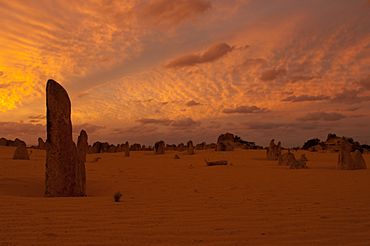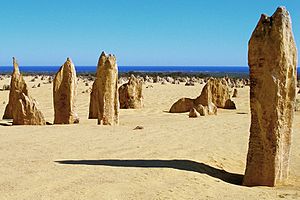Nambung National Park facts for kids
Quick facts for kids Nambung National ParkWestern Australia |
|
|---|---|
|
IUCN Category II (National Park)
|
|

The Pinnacles - natural limestone formations
|
|
| Nearest town or city | Cervantes |
| Established | 1 July 1994 |
| Area | 192.68 km2 (74.4 sq mi) |
| Managing authorities | Department of Biodiversity, Conservation and Attractions |
| Website | Nambung National Park |
| See also | List of protected areas of Western Australia |
Nambung National Park is a cool place in Western Australia. It's about 200 kilometers (124 miles) northwest of Perth, near the small town of Cervantes. This park is famous for its amazing Pinnacles Desert. Here, you'll find thousands of tall, rocky shapes called pinnacles!
The name 'Nambung' comes from an Indigenous Australian word. It might mean 'crooked' or 'winding'. This word was used in 1938 for the Nambung River. The river flows into the park and then vanishes into caves. The Yued people are the traditional owners of this land. They have lived here for a very long time.
Nambung National Park also has beautiful beaches. You can visit Kangaroo Point and Hangover Bay. There are also sandy coastal dunes. In some areas, you'll see low heathland with pretty flowering plants. At Lake Thetis, there's a special boardwalk. It lets visitors see thrombolites. These are like stromatolites, which are structures made by tiny living things. Some fossilized thrombolites are super old, about 3.6 billion years old! The Pinnacles Desert Discovery Centre is also in the park. It has cool exhibits about how the pinnacles formed. It also shares information about the area's history and nature.
Contents
Park History
Europeans first explored this area in 1658. Dutch maps from that time show 'North' and 'South Hummocks'. Phillip Parker King also wrote about these Hummocks in his journals in 1820. The Pinnacles Desert was not well-known until it was mapped in 1934. Nambung National Park was officially created in July 1994. It was formed by joining three smaller protected areas. These areas were set aside in 1956, 1967 (for the Pinnacles), and 1968.
Park Location
The park has the Southern Beekeeper's Nature Reserve to its north. To the south, you'll find the Wanagarren Nature Reserve. A large area of empty government land is along the eastern side. The Indian Ocean forms the park's western edge. Visitors can reach the Pinnacles Desert from the north or south of Cervantes. You can use the Indian Ocean Drive or Cervantes Road from the east. The park is located 17 kilometers (10.5 miles) south of Cervantes.
How the Pinnacles Formed
The Pinnacles Desert has thousands of limestone pillars. These pillars are pieces of limestone that have been worn away by weather. The limestone itself was made from old sea creatures. Things like coral and shells settled on the ocean floor long ago. Some of the tallest pinnacles are up to 3.5 meters (11.5 feet) tall. They rise out of the yellow sand.
There are different kinds of pinnacles. Some are very tall and thin, like columns. This is why they are called 'Pinnacles'. Others are shorter and wider, looking like small tombstones. If you look closely, you might see layers of sand inside some pinnacles. These layers show how the sand was deposited at different angles. This happened because the wind changed direction when the limestone was forming.
Pinnacles with mushroom-shaped tops are also common. This happens when the top layer, called calcrete, is harder than the limestone below it. The softer lower layers wear away faster. This leaves the harder top layer sticking out, creating the mushroom shape.
Animals and Plants
Nambung National Park is home to many different animals. Scientists have seen 176 animal species here. This includes 128 types of birds, 8 mammals, and 15 reptiles. There are also fish, insects, and one type of frog.
Mammals
Some of the mammals you might see are the western grey kangaroo and the red kangaroo. You might also spot a dingo, a honey possum, or a red fox.
Birds
Common birds include the silver gull and the black-faced woodswallow. You might also see the white-backed swallow, the red-capped plover, and the raven.
Reptiles and Amphibians
Reptiles in the park include Buchanan's snake-eyed skink. There's also the yellow-faced whip snake and the bobtail. Bobtails are a type of blue-tongued skink. You might also see a sand goanna. The only frog found here is the sign-bearing froglet.
Ocean Life
Humpback whales swim past the park's coast. They do this during their yearly trips north and south. Sea lions and dolphins live in these waters all year round.
Plants
The park has more than 170 types of flowering plants. Some examples are coastal wattle and sea nymph. You can also find acorn banksia and cowslip orchid. Other plants include ringed wallaby grass and coast hop-bush. The only cone-bearing tree found here is the swamp cypress.
Panorama
See also




